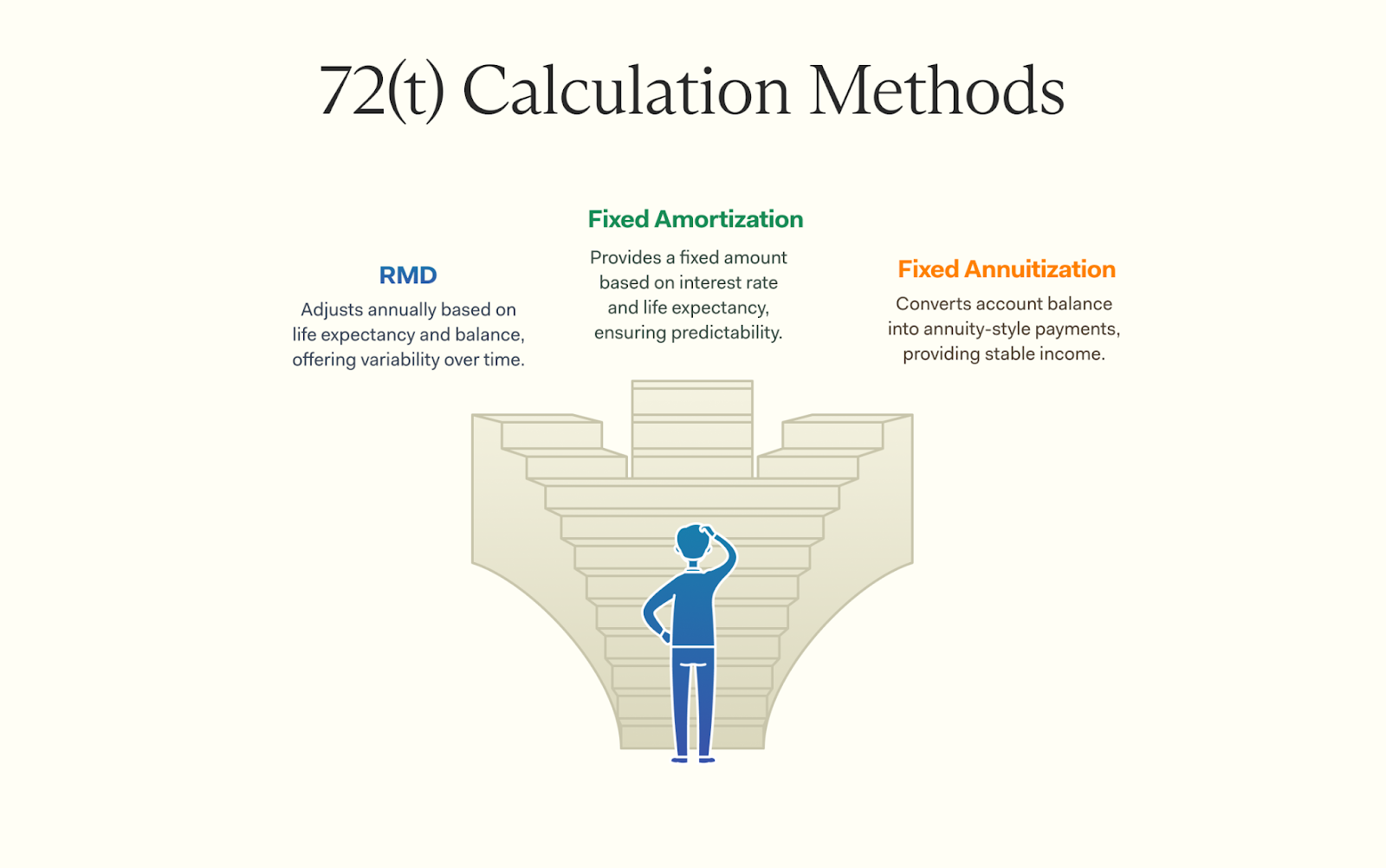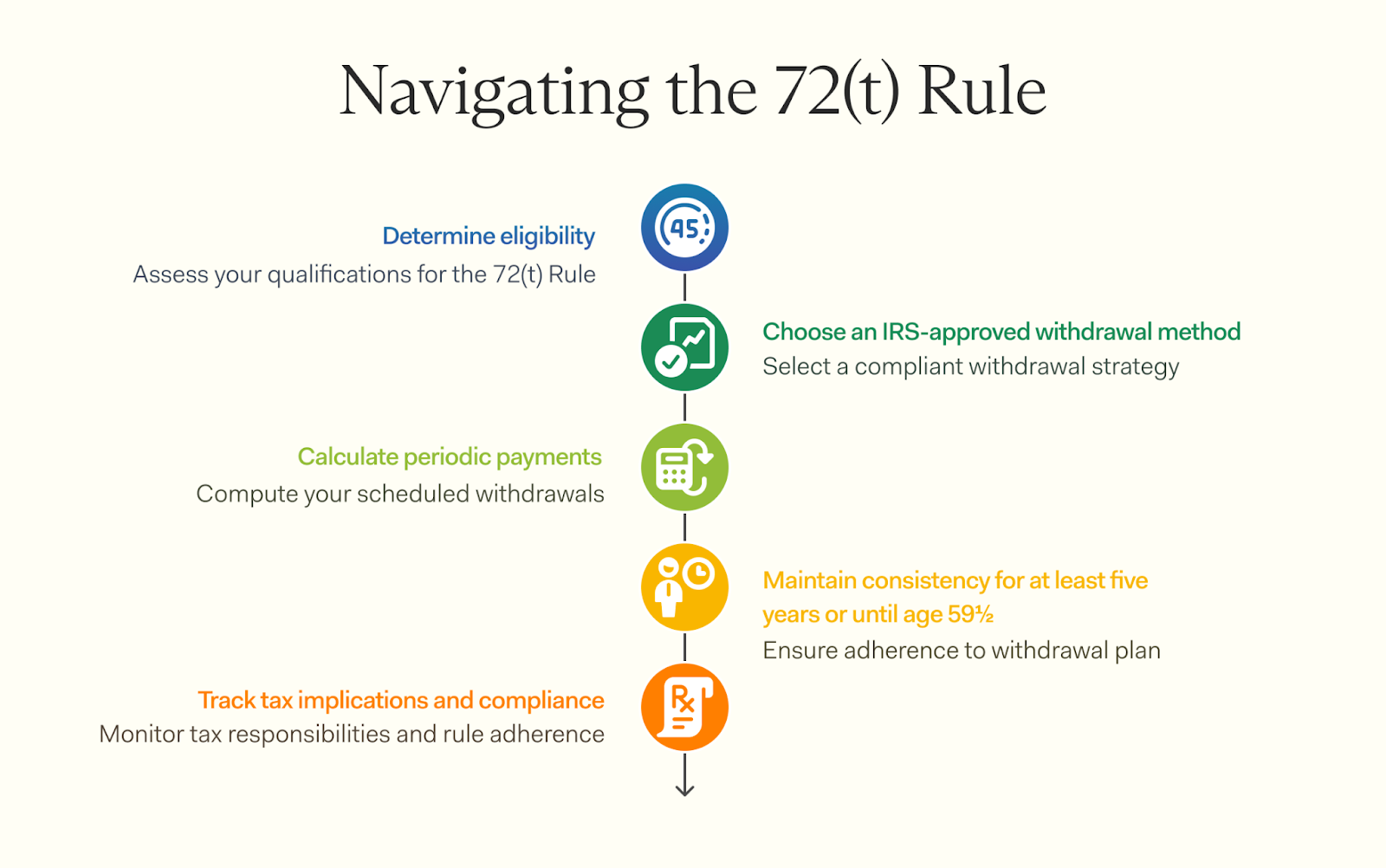Learn how to navigate Rule 72t for early retirement distributions. Discover strategies to access your retirement funds effectively.
Wondering how to access your 401(k) funds before retirement without getting hit with penalties? Rule 72(t) offers a solution that many pre-retirees overlook. This IRS provision allows you to tap into your retirement savings early while avoiding the usual 10% penalty that comes with premature withdrawals.
Through Substantially Equal Periodic Payments (SEPP), rule 72(t) creates a structured withdrawal system that satisfies IRS requirements.
This guide breaks down exactly how SEPP works, walks you through the three IRS-approved calculation methods for determining your payment amounts, and provides essential details about implementing rule 72(t) to access your retirement funds on your terms.

This IRS provision allows people to pull funds from their retirement accounts early, avoiding the usual penalty. The rule applies to various accounts such as IRAs, 401(k)s, 403(b)s, and other qualified plans. You must take substantially equal periodic payments for at least five years or until you're 59 and a half, whichever comes later.
To decide your yearly withdrawal amount, you can use three IRS-approved methods: Required Minimum Distribution (RMD), Fixed Amortization, and Fixed Annuitization. These methods calculate your payments based on your account balance and life expectancy, using IRS tables. Though these three methods are standard, other reasonable methods that satisfy IRS requirements may also be considered.
Some methods also use an interest rate to calculate your payments. While the chosen method generally sets the payment amount for the duration of the SEPP period, there is a one-time allowance to switch from the fixed amortization or fixed annuitization method to the required minimum distribution method without penalty. Planning wisely is vital to ensure that your account maintains sufficient funds to support these payments without incurring penalties. Additionally, the payments must be substantially equal, using one of the IRS-approved methods to ensure consistency and compliance with early distributions.
SEPP allows early withdrawals from retirement funds without penalties, following IRS rules for consistent payments.
SEPP programs let you take money from your 401(k), IRA, 403(b), and other qualified retirement accounts early without a penalty. This option is for those who want to withdraw funds before age 59½. SEPP allows account holders to receive payments over time.
To qualify, you must follow IRS rules carefully. While you generally cannot change the payment amount once you start, there is a one-time allowance to switch from the fixed amortization or fixed annuitization method to the required minimum distribution method. It's important to primarily use one of the three IRS-approved methods: Required Minimum Distribution (RMD) Method, Fixed Amortization Method, or Fixed Annuitization Method, although other reasonable methods may also qualify.
Each method has its own way to calculate payment amounts based on factors like age and account balance.
The eligibility requirements for the 72(t) Rule are specific. You must meet certain criteria to make penalty-free withdrawals.
Understanding these requirements can help you navigate early retirement options better.
The IRS offers three ways to withdraw money early from your 401(k) without penalties. Each method has its own rules and calculations that can affect how much you take out each year....
The RMD Method is one of the three IRS-approved methods for taking early 401(k) withdrawals. This method calculates your annual payments based on your account balance and life expectancy.
To find the amount, divide your taxpayer's account balance by a specific number from life expectancy tables.
This method uses the Uniform Lifetime Table for most people. If you have a spouse who is more than ten years younger, you may use the Joint Life Expectancy Table. These calculations let you take penalty-free withdrawals if you meet certain conditions.
Following this method helps simplify minimum distribution requirements while keeping track of your retirement savings.
This calculation method offers a way to take early withdrawals from your 401(k) without penalties. It determines equal payments based on your account balance and an assumed interest rate.
Payments continue for a set period or until you reach the age of 59½.
To use this method, choose an annuity factor from IRS tables. You also need to calculate your required distribution period based on life expectancy. This approach helps spread out your withdrawals evenly over time.
It can be a good option if you want steady income while avoiding hefty taxes or penalties for early withdrawal.
Moving on from the Fixed Amortization Method, the Fixed Annuitization Method offers another option under the 72(t) Rule. This method uses an annuity to determine your payments. It converts your account balance into a series of consistent payments over time.
You will need to choose a life expectancy table for this method. A common choice is the Single Life Expectancy Table, based on your age. Payments remain steady until you exhaust your account balance.
The IRS allows these payments without penalties if you stick to their rules and timing guidelines. Penalty-free withdrawals are possible, making this a viable path for those looking to retire early or access funds sooner than usual.
The 72(t) Rule offers some clear benefits. It allows for penalty-free withdrawals from your 401(k) before age 59½. This means you can access your funds in times of need without facing the usual 10% early withdrawal penalty.
The Substantially Equal Periodic Payments (SEPP) method lets you take out a steady amount over time, based on IRS guidelines. Using this rule properly can provide needed cash flow during tough times.
Still, there are downsides to consider. Once you start SEPP, you must stick with it for at least five years or until you turn 59½—whichever comes later. If not, penalties may apply retroactively.
Also, withdrawing too much too soon could hurt your retirement savings. Understanding these limitations is crucial before making any moves with your employer-sponsored retirement plans and using methods like the Required Minimum Distribution (RMD).
Always think carefully about how early withdrawals might impact your future financial stability.

Real-world examples show how the 72(t) Rule can help people take money from their 401(k) early. Here are some key applications:
Several options exist besides the 72(t) Rule for early withdrawals. One such choice is to take a loan from your 401(k). Many employer-sponsored retirement plans allow loans. You can borrow the lesser of $50,000 or 50% of your vested account balance. If your vested balance is less than $20,000, you may be able to borrow up to $10,000.
Just repay it on time to avoid penalties.
Another alternative is hardship withdrawals. These let you take money for immediate and heavy financial needs such as medical expenses, purchasing a principal residence, paying tuition and educational fees, preventing eviction or foreclosure, covering burial or funeral expenses, and certain repairs to your principal residence. The IRS has strict rules about what qualifies as a hardship, so check those carefully before applying.
Using these methods may not incur the premature distribution penalty, but 401(k) loans, if not repaid on time, and hardship withdrawals are subject to ordinary income tax. Additionally, hardship withdrawals may also incur a 10% early withdrawal penalty unless an exception applies.
Managing early withdrawals can be tricky. Here are some solid tips to help you handle this process.
The 72(t) rule provides a pathway to penalty-free withdrawals through Substantially Equal Periodic Payments (SEPPs) if you have separated from service with the employer maintaining the plan before the payments begin. While this strategy offers financial flexibility, it comes with strict rules and long-term implications, including a recapture tax if you modify the SEPP before the later of five years or reaching age 59½.
Considering early withdrawals? Consult with a Farther financial advisor to ensure it aligns with your retirement goals!
The 72(t) Rule isn't just a loophole—it's a strategic way to access your 401(k) early without penalties. By using Substantially Equal Periodic Payments (SEPP), you can tap into your retirement funds through three IRS-approved methods: RMD, Fixed Amortization, and Fixed Annuitization.
Need flexibility with your savings? These options provide a path to financial freedom before retirement. Explore your choices, plan wisely, and make your money work for you!
The 72(t) rule, part of the Internal Revenue Code, allows for penalty-free early withdrawals from certain retirement accounts such as IRAs and employer-sponsored plans like 401(k)s, through substantially equal periodic payments (SEPPs). For employer-sponsored plans, an individual needs to have separated from service with the employer maintaining the plan before the payments begin.
Sure! The Equal Periodic Payments or SEPP involves taking out a series of substantially equal payments from your retirement account over your life expectancy or the joint life expectancy of you and your designated beneficiary. The IRS provides three methods to calculate these payments: the required minimum distribution method, the fixed amortization method, and the fixed annuitization method.
The Required Minimum Distribution (RMD) method calculates each year's withdrawal by dividing the account balance as of December 31 of the previous year by the life expectancy factor from the appropriate IRS life expectancy table. This amount is recalculated annually, reflecting changes in the account balance and in the account holder's age.
Yes, there are two additional methods, known as the fixed amortization method and the fixed annuitization method. The fixed amortization method calculates payments by amortizing the account balance over a specified number of years using a chosen interest rate, while the fixed annuitization method determines payments using an annuity factor based on the account holder's age and a chosen interest rate.
Choosing between single and joint life expectancy tables depends on whether you have a designated beneficiary and their age relative to yours. If your spouse is more than 10 years younger and is the sole beneficiary, you may use the Joint and Last Survivor Table; otherwise, the Single Life Table or Uniform Lifetime Table may be more appropriate.
The required distribution period under the SEPP rules ends either after five years or when you reach age 59½, whichever comes later.